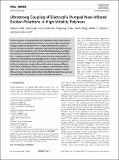Ultrastrong coupling of electrically pumped near-infrared exciton-polaritons in high mobility polymers
Abstract
Exciton-polaritons are quasiparticles with hybrid light–matter properties that may be used in new optoelectronic devices. Here, electrically pumped ultrastrongly coupled exciton-polaritons in a high-mobility donor–acceptor copolymer are demonstrated by integrating a light-emitting field-effect transistor into a metal-clad microcavity. Near-infrared electroluminescence is emitted exclusively from the lower polariton branch, which indicates efficient relaxation. A coupling strength of 24% of the exciton transition energy implies the system is in the ultrastrong coupling regime with a narrow and almost angle-independent emission. The lower polariton energy, which can be adjusted by the cavity detuning, strongly influences the external quantum efficiency of the device. Driving the transistors at ambipolar current densities of up to 4000 A cm−2 does not decrease the coupling strength or polariton emission efficiency. Cavity-integrated light-emitting field-effect transistors thus represent a versatile platform for polariton emission and polaritonic devices.
Citation
Held , M , Graf , A , Zakharko , Y , Chao , P , Tropf , L , Gather , M C & Zaumseil , J 2018 , ' Ultrastrong coupling of electrically pumped near-infrared exciton-polaritons in high mobility polymers ' , Advanced Optical Materials , vol. 6 , no. 3 , 1700962 . https://doi.org/10.1002/adom.201700962
Publication
Advanced Optical Materials
Status
Peer reviewed
ISSN
2195-1071Type
Journal article
Description
This research was financially supported by the European Research Council under the European Union's Seventh Framework Programme (FP/2007- 2013)/ERC Grant Agreement No. 306298 (EN -LUMINATE) and under the European Union’s Horizon 2020 Framework Programme (FP/2014- 2020)/ERC Grant Agreement No. 640012 (ABLASE) and by the EPSRC Programme Grant EP/P030017/1. L.T. thanks EPSRC for support through the CM -DTC (EP/L015110/1).Collections
Items in the St Andrews Research Repository are protected by copyright, with all rights reserved, unless otherwise indicated.

